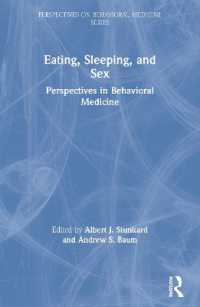- ホーム
- > 洋書
- > 英文書
- > Science / Mathematics
Full Description
Learn Chemical Reaction Engineering through Reasoning, Not MemorizationEssentials of Chemical Reaction Engineering is the complete, modern introduction to chemical reaction engineering for today's undergraduate students. Starting from the strengths of his classic Elements of Chemical Reaction Engineering, Fourth Edition, in this volume H. Scott Fogler added new material and distilled the essentials for undergraduate students.Fogler's unique way of presenting the material helps students gain a deep, intuitive understanding of the field's essentials through reasoning, using a CRE algorithm, not memorization. He especially focuses on important new energy and safety issues, ranging from solar and biomass applications to the avoidance of runaway reactions. Thoroughly classroom tested, this text reflects feedback from hundreds of students at the University of Michigan and other leading universities. It also provides new resources to help students discover how reactors behave in diverse situations-including many realistic, interactive simulations on DVD-ROM.New Coverage IncludesGreater emphasis on safety: following the recommendations of theChemical Safety Board (CSB), discussion of crucial safety topics, including ammonium nitrate CSTR explosions, case studies of the nitroaniline explosion, and the T2 Laboratories batch reactor runawaySolar energy conversions: chemical, thermal, and catalytic water spillingAlgae production for biomassSteady-state nonisothermal reactor design: flow reactors with heat exchangeUnsteady-state nonisothermal reactor design with case studies of reactor explosionsAbout the DVD-ROMThe DVD contains six additional, graduate-level chapters covering catalyst decay, external diffusion effects on heterogeneous reactions, diffusion and reaction, distribution of residence times for reactors, models for non-ideal reactors, and radial and axial temperature variations in tubular reactions. Extensive additional DVD resources includeSummary notes, Web modules, additional examples, derivations, audio commentary, and self-testsInteractive computer games that review and apply important chapter conceptsInnovative "Living Example Problems" with Polymath code that can be loaded directly from the DVD so students can play with the solution to get an innate feeling of how reactors operateA 15-day trial of Polymath (TM) is included, along with a link to the Fogler Polymath siteA complete, new AspenTech tutorial, and four complete example problemsVisual Encyclopedia of Equipment, Reactor Lab, and other intuitive toolsMore than 500 PowerPoint slides of lecture notes Additional updates, applications, and information are available at www.umich.edu/‾essen and www.essentialsofcre.com.
Contents
Preface xvAbout the Author xxixChapter 1: Mole Balances 11.1 The Rate of Reaction, -rA 41.2 The General Mole Balance Equation 81.3 Batch Reactors (BRs) 101.4 Continuous-Flow Reactors 121.5 Industrial Reactors 22Chapter 2: Conversion and Reactor Sizing 332.1 Definition of Conversion 342.2 Batch Reactor Design Equations 342.3 Design Equations for Flow Reactors 372.4 Sizing Continuous-Flow Reactors 402.5 Reactors in Series 492.6 Some Further Definitions 60Chapter 3: Rate Laws 733.1 Basic Definitions 743.2 The Reaction Order and the Rate Law 763.3 The Reaction Rate Constant 863.4 Present Status of Our Approach to Reactor Sizing and Design 93Chapter 4: Stoichiometry 1054.1 Batch Systems 1074.2 Flow Systems 113Chapter 5: Isothermal Reactor Design: Conversion 1395.1 Design Structure for Isothermal Reactors 1405.2 Batch Reactors (BRs) 1445.3 Continuous Stirred Tank Reactors (CSTRs) 1525.4 Tubular Reactors 1625.5 Pressure Drop in Reactors 1695.6 Synthesizing the Design of a Chemical Plant 188Chapter 6: Isothermal Reactor Design: Molar Flow Rates 2076.1 The Molar Flow Rate Balance Algorithm 2086.2 Mole Balances on CSTRs, PFRs, PBRs, and Batch Reactors 2086.3 Applications of the Molar Flow Rate Algorithm to Microreactors 2126.4 Membrane Reactors 2176.5 Unsteady-State Operation of Stirred Reactors 2256.6 Semibatch Reactors 226Chapter 7: Collection and Analysis of Rate Data 2457.1 The Algorithm for Data Analysis 2467.2 Determining the Reaction Order for Each of Two Reactants Using the Method of Excess 2487.3 Integral Method 2497.4 Differential Method of Analysis 2537.5 Nonlinear Regression 2597.6 Reaction Rate Data from Differential Reactors 2647.7 Experimental Planning 271Chapter 8: Multiple Reactions 2838.1 Definitions 2838.2 Algorithm for Multiple Reactions 2868.3 Parallel Reactions 2898.4 Reactions in Series 2988.5 Complex Reactions 3088.6 Membrane Reactors to Improve Selectivity in Multiple Reactions 3168.7 Sorting It All Out 3218.8 The Fun Part 321Chapter 9: Reaction Mechanisms, Pathways, Bioreactions, and Bioreactors 3399.1 Active Intermediates and Nonelementary Rate Laws 3409.2 Enzymatic Reaction Fundamentals 3499.3 Inhibition of Enzyme Reactions 3649.4 Bioreactors and Biosynthesis 371Chapter 10: Catalysis and Catalytic Reactors 40910.1 Catalysts 40910.2 Steps in a Catalytic Reaction 41510.3 Synthesizing a Rate Law, Mechanism, and Rate-Limiting Step 43110.4 Heterogeneous Data Analysis for Reactor Design 44610.5 Reaction Engineering in Microelectronic Fabrication 45610.6 Model Discrimination 461Chapter 11: Nonisothermal Reactor Design-The Steady State Energy Balance and Adiabatic PFR Applications 47711.1 Rationale 47811.2 The Energy Balance 47911.3 The User Friendly Energy Balance Equations 48611.4 Adiabatic Operation 49211.5 Adiabatic Equilibrium Conversion and Reactor Staging 50211.6 Optimum Feed Temperature 509Chapter 12: Steady-State Nonisothermal Reactor Design-Flow Reactors with Heat Exchange 52112.1 Steady-State Tubular Reactor with Heat Exchange 52212.2 Balance on the Heat Transfer Fluid 52512.3 Algorithm for PFR/PBR Design with Heat Effects 52712.4 CSTR with Heat Effects 54512.5 Multiple Steady States (MSS) 55612.6 Nonisothermal Multiple Chemical Reactions 56312.7 Safety 577Chapter 13: Unsteady-State Nonisothermal Reactor Design 60113.1 The Unsteady-State Energy Balance 60213.2 Energy Balance on Batch Reactors 60413.3 Semibatch Reactors with a Heat Exchanger 61513.4 Unsteady Operation of a CSTR 62013.5 Nonisothermal Multiple Reactions 624Appendix A: Numerical Techniques 649Appendix B: Ideal Gas Constant and Conversion Factors 655Appendix C: Thermodynamic Relationships Involving the Equilibrium Constant 659Appendix D: Nomenclature 665Appendix E: Software Packages 669E.1 Polymath 669E.2 AspenTech 670E.3 COMSOL 671E.4 Software Packages 671Appendix F: Rate Law Data 673Appendix G: Open-Ended Problems 675G.1 Design of Reaction Engineering Experiment 675G.2 Effective Lubricant Design 675G.3 Peach Bottom Nuclear Reactor 675G.4 Underground Wet Oxidation 675G.5 Hydrodesulfurization Reactor Design 676G.6 Continuous Bioprocessing 676G.7 Methanol Synthesis 676G.8 Alcohol Metabolism 676G.9 Methanol Poisoning 676G.10 Cajun Seafood Gumbo 676Appendix H: How to Use the DVD-ROM 679H.1 DVD-ROM Components 679H.2 How the DVD-ROM/Web Can Help Learning Styles 682H.3 Navigation 683Index 685






